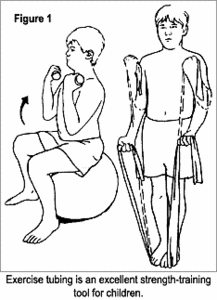New York's highest court of appeals has held that no-fault insurers cannot deny no-fault benefits where they unilaterally determine that a provider has committed misconduct based upon alleged fraudulent conduct. The Court held that this authority belongs solely to state regulators, specifically New York's Board of Regents, which oversees professional licensing and discipline. This follows a similar recent ruling in Florida reported in this publication.
Does Rehab Work for Youngsters?
Most chiropractors acknowledge the effective role rehabilitative exercise plays in improving the lives of adult patients. But how effective is exercise for children, especially exercise with resistance? Which exercises are most effective? How safe is it for kids, and what level of weight is appropriate for a growing body?
Some doctors of chiropractic may be reluctant to recommend exercises for their younger patients unless they have some answers. As a general statement, all children should be encouraged to engage in frequent and regular fitness activities. However, since needs usually vary during growth, selecting the best exercise approach for each child's situation is important.1
Lasting Effects
The benefits of physical activity in children include fitness, weight control, and the development of what can become lifelong habits. One study determined the amount of moderate to vigorous physical activity students obtain during elementary and middle school physical education classes (time spent performing moderate to vigorous physical activity compared to total class time). The researchers concluded that the amount of physical activity observed (elementary schools, 8.6 percent; middle schools, 16.1 percent) was significantly less than the estimated national average of 27 percent, and far below the national recommendation of a minimum of 50 percent.2
Contemporary fitness data indicates that children in the United States are heavier, slower and weaker than children in many other developed nations. Also, American children appear to be developing a sedentary lifestyle at earlier ages. A low level of exercise is a contributing factor for childhood obesity and hypertension, and predisposes the individual to premature death from coronary heart disease.3 Fortunately, through intervention in the form of education and motivation, exercise levels may be increased to the recommended minimum of 30 minutes on most days.4
Safety Issues
High-intensity resistance training appears to be effective in increasing strength in pre-adolescents. Children make similar relative, but smaller absolute strength gains when compared with adolescents and young adults. Resistance training appears to have little, if any, hypertrophic effect rather than being associated with increased levels of neuromuscular activation.
Researchers have found that the risk of injury from prudently prescribed and closely supervised resistance training appears to be low during pre-adolescence.5 One 1993 study reviewed the types and causes of injuries to pre-adolescents and adolescents resulting from weight lifting/training. The researchers concluded that "pre-pubescent and older athletes who are well-trained and supervised appear to have low injury rates in strength training programs."6
One risk that must be considered in the immature skeleton is the susceptibility of the growth cartilage of the epiphyseal plates (physes). Weight training in a submaximal controlled, supervised situation is beneficial to bone deposition. Strength training can be a valuable and safe mode of exercise as long as instructors are properly educated; participants are properly instructed; and the absolute necessity of avoiding maximal lifts is reinforced.7
The most important factors in avoiding injury in children who are doing resistance exercises are: proper exercise performance; avoiding overload by focusing on repetitions, not weight; enforcing rest periods during exercise; and resistance training only twice a week. Exercise tubing is an excellent tool for strength training of children, since the risks of injury are minimized, and a spotter or expensive equipment is not needed (see Figure 1).

It is more important for many children to learn the fine neurological control necessary for accurate spinal and full-body performance than to just build strength. Better balance and coordination often result in improved physical function, both in daily and sports activities. This may entail performing exercises while standing on one leg, with the eyes closed, while standing on a mini-trampoline, or using a rocker board. The advantage of these balance exercises is seen when children engage in sports activities and perform at advanced levels for their age group.
Exercises are effective when done in an upright, weight-bearing position, since the entire body is in a closed-chain position during the training. The stabilizing muscles, the co-contractors, and the antagonist muscles all learn to coordinate with the major movers during movements that are performed during closed-chain exercising. This makes these types of exercises quite valuable in the long run, particularly for children who are interested in becoming competitive athletes.
Exercises for Postural Correction
Spinal problems in children are often associated with poor postural support. A spinal asymmetry such as scoliosis or kyphosis is invariably accompanied by neuromuscular imbalance. This may be compounded by poor postural habits and tendencies to slump.
One important factor in chiropractic care is the correction of any loss of the normal upright alignment of the pelvis and spine. In addition to general strengthening and coordination exercises, patients (including children) should be shown corrective exercises that are specific for the postural imbalances they have developed. For instance, when the pelvis is carried flexed forward, a patient of any age will need to retrain with resisted pelvic extension exercises. Likewise, when there is a forward head, posterior translation exercises for the cervical region are very important.
Whenever a child shows evidence of abnormal gait or begins to develop lower extremity complaints, a careful evaluation for the need for posturally supporting the pedal foundation is warranted.
Exercise tubing is an excellent strength-training tool for children.
Safety and Effectiveness
With a few commonsense cautions and careful supervision, children are capable of performing rehabilitative exercises very safely. A well-designed exercise program for children who need to gain strength, develop better coordination, and improve postural support will allow the doctor of chiropractic to provide cost-efficient pediatric spinal care. The end result is a more effective rehab component and young patients who will make a rapid response to their chiropractic care.
References
- American College of Sports Medicine. Guidelines for Exercise Testing and Prescription, 6th ed. Philadelphia: Lippincott Williams & Wilkins, 2000.
- Simons-Morton BG, Taylor WC, et al. Observed levels of elementary and middle school children's physical activity during physical education classes. Prevent Med 1994;23:437-441.
- Cunnane SC. Childhood origins of lifestyle-related risk factors for coronary heart disease in adulthood. Nutr Health 1993;9:107-115.
- U.S. Dept. of Health and Human Services. Physical Activity and Health: a Report of the Surgeon General. Atlanta, 1996.
- Blimke CJ. Resistance training during preadolescence: issues and controversies. Sports Med 1993;15:389-407.
- Mazur LJ, Etman RJ, Risser WL. Weight-training injuries: common injuries and preventative methods. Sports Med 1993; 16:57-63.
- Schafer J. Prepubescent and adolescent weight training: is it safe? Is it beneficial? Natl Strength Conditioning Assoc J 1991;13:39-45.
Kim Christensen, DC, DACRB, CCSP, CSCS
Director, Chiropractic Rehabilitation and Wellness Program
PeaceHealth Hospital
Longview, Washington
kchristensen@peacehealth.org



